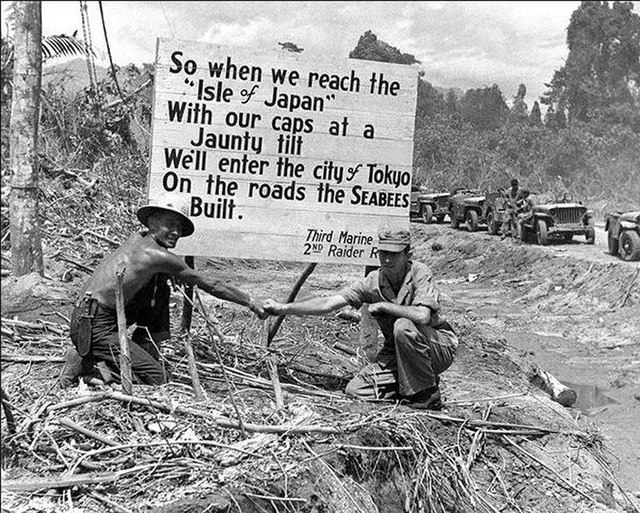When World War II broke out the United States Naval Construction Battalions (Seabees) did not exist. The logistics of a two theater war were daunting to conceive. Rear Admiral Moreell completely understood the issues. What needed to be done was build staging bases to take the war to the enemy, across both oceans, and create the construction force to do the work. Naval Construction Battalions were first conceived at Bureau of Yards and Docks (BuDocks) in the 1930s. The onset of hostilities clarified to Radm. Moreell the need for developing advance bases to project American power. The solution: tap the vast pool of skilled labor in the U.S. Put it in uniform to build anything, anywhere under any conditions and get the Marine Corps to train it. The first volunteers came skilled. To obtain these tradesmen, military age was waived to age 50. It was later found that several past 60 had managed to get in. Men were given advanced rank/pay based upon experience making the Seabees the highest paid group in the U.S. military. The first 60 battalions had an average age of 37.

3rd Marine Division, 2nd Raider's sign on Bougainville
WWII recruitment poster
African American Seabee color guard
Early Seabee pennants with first pattern Seabee for use as an equipment stencil per BuDocks order (not for uniforms).
The Civil Engineer Corps (CEC) is a staff corps of the United States Navy. CEC officers are professional engineers and architects, acquisitions specialists, and Seabee Combat Warfare Officers who qualify within Seabee units. They are responsible for executing and managing the planning, design, acquisition, construction, operation, and maintenance of the Navy's shore facilities. The Civil Engineer Corps is under the command of the Chief of Civil Engineers and Commander, Naval Facilities Engineering Systems Command. On 12 August 2022, RADM Dean VanderLey relieved RADM John W. Korka, becoming the 46th commander of NAVFAC and Chief of Civil Engineers.
U.S. Naval Civil Engineer Corps Insignia
WWII Naval Officers from the Civil Engineer Corps, Medical Corps, Dental Corps and Supply Corps assigned to Naval Construction Battalions had a Silver Seabee on their Corps insignia.
Capt. John N. Laycock (CEC) discussing his modular pontoon box system with Admiral Moreell.
Lt Cmdr. Edward Swain Hope CEC was the most senior African American officer in the United States Navy during WWII.








